HEAT for Class 7 SCIENCE
Introduction
Hamne previous chapter mein padha ki woollen clothes animal fibres se bante hai aur winters mein pehne jate hai, cotton clothes plants fibres se bante hai aur summers mein pehne jate hai. Woolen clothes winters mein isliye pehne jate hai kyonki wo hamein warm rakhte hai. Light coloured cotton clothes hum summers mein isliye pehnte hai kyonki inme hum cool feel karte hai. Lekin aisa kyon hota hai?
Winters mein hamein ghar ke andar cold lagta hai aur bahar sunlight mein aa kar warm feel hota hai. Lekin summers mein ghar ke andar bhi hamein hot feel hota hai. Lekin aisa kyon hota hai?
Inn sab questions ke answer hamein iss chapter mein milenge. Iss chapter mein hum hot aur cold objects ke baare mein padhenge, hotness aur coldness ko kaise aur kis instrument se measure kiya jata hai yeh bhi padhenge. Iss chapter mein hum heat ke transfer ke process ko bhi padhenge aur isse related daily life ke kuchh examples bhi dekhenge.
Hot And Cold
Daily hum bahut saare aise objects dekhte hai. Kuchh hot hote hai aur kuchh cold hote hai. Eg- Tea hot hoti hai, ice cold hoti hai. Hum aise hi hot aur cold objects ki ek list banayenge.
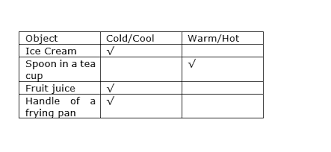
Hamein jyada hot objects ko touch nahi karna chahiye. Candle flame ya stove ko hamein carefully handle karna chahiye. Hamein yeh to pata hai ki kuchh objects dusre objects se jyada hot hote hai Lekin hamein yeh kaise pata chalega ki kounsa object kitna hot hai. Iske liye hum ek activity perform karenge.
Activity
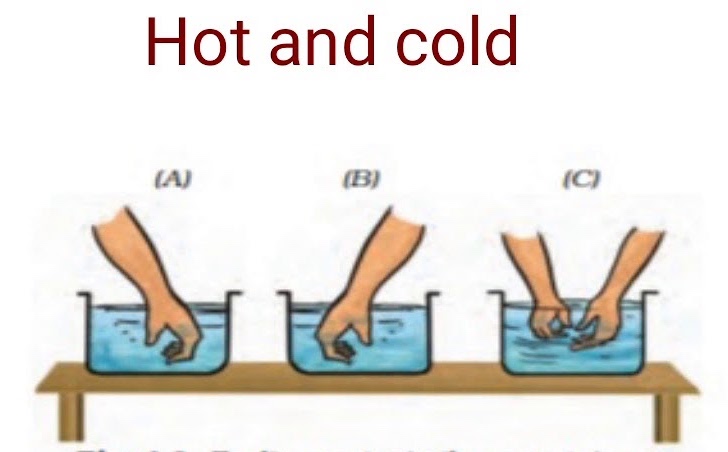
Temperature: A reliable measure of the hotness or coldness of an object is known as its temperature.
Temperature ko ek device se measure kiya jata hai jisko hum thermometer kehte hai.
Measuring Temperature
Jab bhi hamein fever hota hai toh hum thermometer se temperature measure karte hai. Ek aisa thermometer jisse hum body ka temperature measure karte hai usko Clinical thermometer kehte hai. Niche figure mein hum clinical thermometer dekh sakte hai.
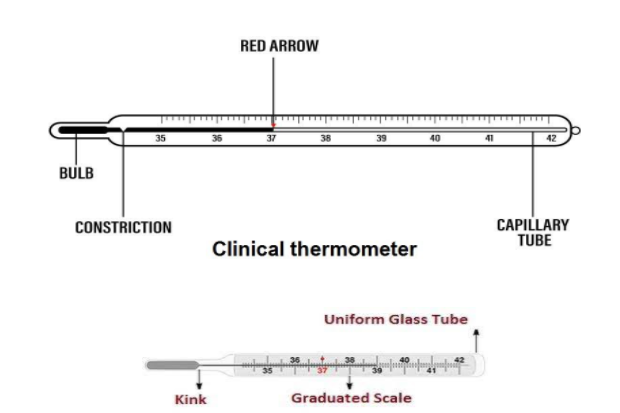
Ek clinical thermometer mein ek long, narrow, uniform glass tube hoti hai. Iske ek end par bulb hota hai. Iss bulb mein mercury hota hai. Bulb ke bahar mercury ka ek small shiny thread hota hai. Agar apko yeh thread nahi dikhta to thermometer ko thoda sa tilt kar ke dekhiye.
Thermometer par ek scale bhi hota hai. Yeh scale degree celsius mein hota hai. Isko .∘C se indicate karte hai. Ek clinical thermometer mein 35∘C se 42∘C tak temperature reading hota hai. Clinical thermometer mein ek kink bhi hota hai, yeh mercury level ko fall hone se bachata hai.
Pehle thermometer mein ek aur scale bhi use kiya jata tha jisko Fahrenheit scale (.∘F) kehte hai. Fahrenheit thermometer hum niche figure mein dekh sakte hai.
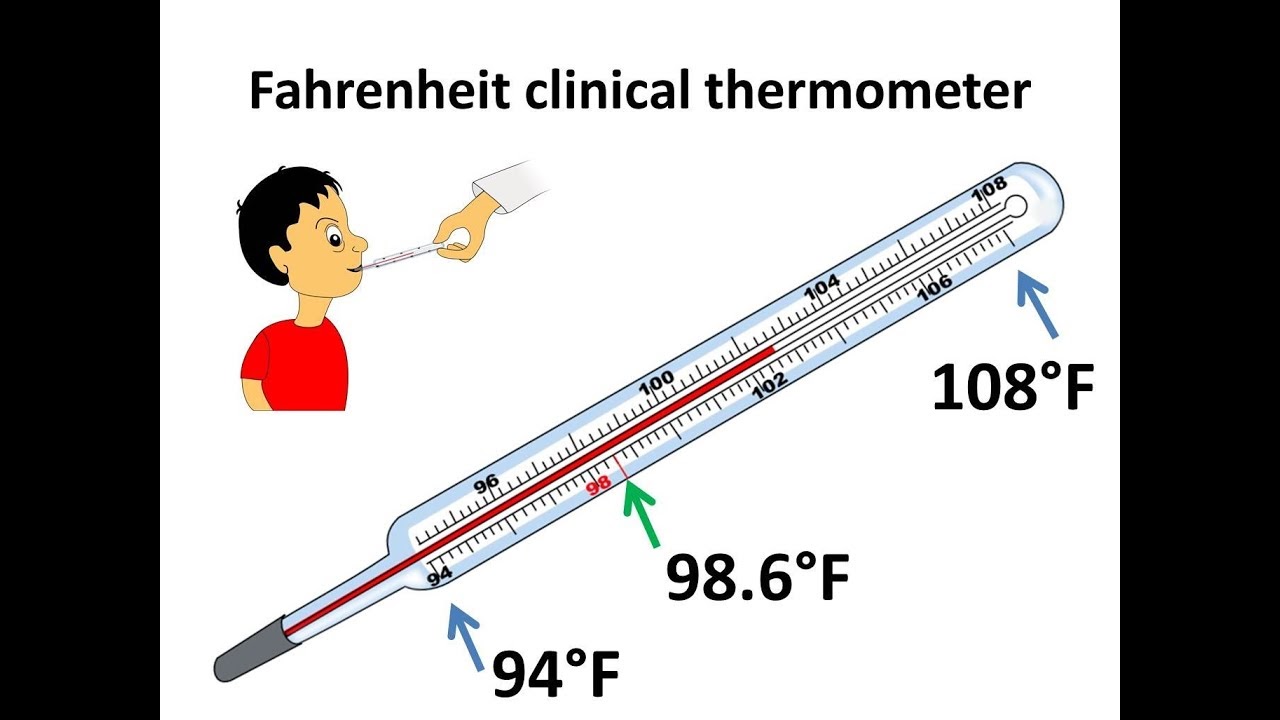
Ab hum dekhte hai ki thermometer ki reading kaise li jati hai.
Reading a thermometer

Human body ka normal temperature 37∘C hota hai. Lekin every person ka body temperature 37∘C nahi ho sakta. Kisi ka body temperature slightly high hota hai aur kisi ka body temperature slightly low hota hai. Toh 37∘C ko hum healthy person ki body ka average temperature bhi bol sakte hai.
Clinical thermometer human body ka temperature measure karne ke liye hi design kiya gaya hai. Normally human body ka temperature 35∘C se less aur 42∘C se jyada nahi hota. Isiliye thermometer ki range 35∘C se 42∘C tak hota hai.
Note: Clinical thermometer ko human body ke alawa kisi aur object ka temperature measure karne ke liye use nahi karna chahiye. Isko sunlight ya flame ke paas bhi nahi rakhna chahiye otherwise yeh break ho sakta hai.
Precautions While using a clinical thermometer

Laboratory Thermometer
Clinical thermometer se only human body ka temperature measure kiya jata hai isliye other objects ka temperature measure karne ke liye ek aur thermometer use kiya jata hai jisko hum laboratory thermometer kehte hai. Laboratory thermometer ki range generally 10∘C se 110∘C hoti hai.

Reading a Laboratory Thermometer
Different purpose ke liye different thermometers use kiye jate hai. Weather reports mein previous day ka maximum aur minimum temperature report karne ke liye ek thermometer use kiya jata hai jisko hum maximum-minimum thermometer kehte hai.
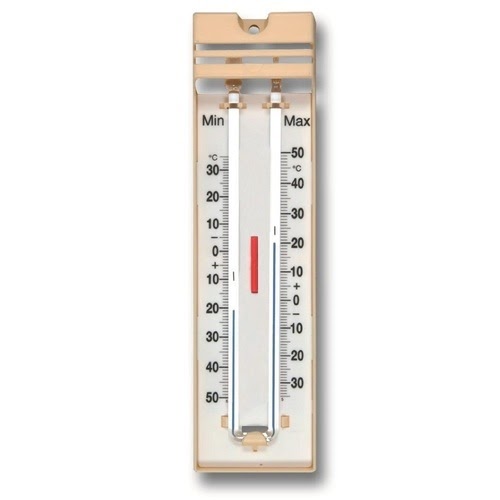
Aaj-kal mercury thermometers ki jagah digital thermometers use kiye jate hai kyonki mercury ek toxic substance hai aur isko dispose off karna bahut difficult hota hai.
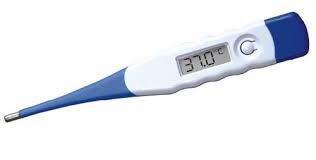
POINT 1
Temperature: The degree of hotness or coldness of the object is known as the temperature of an object.
Clinical Thermometer: The thermometer that measures our body temperature is called a clinical thermometer.
Transfer of Heat
Heat ka transfer hotter object se colder object mein hota hai. Heat ka transfer higher temperature se lower temperature ki taraf hota hai. Iss flow of heat ko hi transfer of heat kehte hai. Eg- Hum kabhi kisi frying pan ko flame par rakhte hai to wo hot ho jata hai. Aisa isliye hota hai kyonki flame se utensil mein heat pass on hoti hai. Lekin jab hum us utensil ko flame se remove karte hai toh wo slowly cool down hona start ho jata hai. Heat pan se surroundings mein transfer hoti hai.
Heat three ways se transfer hoti hai- Conduction, convection and radiation.
Conduction- Ek aisa process jisse heat hotter end se colder end mein transfer hoti hai usko conduction kehte hai. Solids mein generally heat conduction ke process se transfer hoti hai.
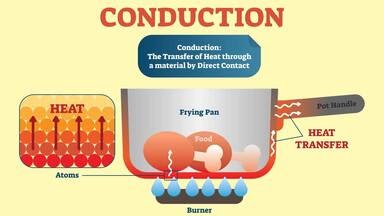
Conductors: Aise materials jo heat ko apne aap mein se pass hone dete hai unko conductors kehte hai. Eg- Aluminium, iron and copper.
Insulators: Aise materials jo heat ko apne aap mein se pass nahi hone dete aise materials ko poor conductor of heat kehte hai. Inhi poor conductors ko insulator kaha jata hai. Eg- Water aur air heat ke poor conductors hote hai.
Convection: Yeh heat transfer ka ek process hota hai, isme liquid aur gases mein bulk molecules ka movement hota hai aur molecules ki heating hoti hai. Eg- Hum ek liquid ko pan mein daal kar flame par heat karne ke liye rakhte hai toh hum dekhte hai jaise hi paani heat hone lagta hai toh molecules move karna start kar dete hai. Jo molecules heat ho jate hai vo upar move karna start kar dete hai aur thande molecules niche aana start ho jate hai. Iss process se jo heating hoti hai usko convection kehte hai. Sea breeze aur land breeze bhi convection of air aur water se hi hoti hai.
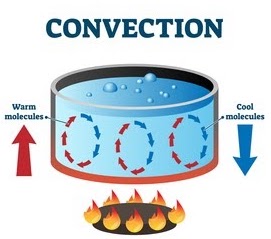
Sea breeze and Land breeze
Coastal areas mein generally jo land breeze aur sea breeze chalti hai vo convection of air ki vajah se chalti hai. Ab hum sea breeze aur land breeze ke baare mein detail mein padhenge.
Sea breeze
Day time mein coastal areas mein land water se bhi jyada garam ho jati hai. Land ke upar ki air bhi iss vajah se garam ho jati hai aur garam hone ki vajah se air halki ho jati hai. Halki air upar ki taraf move karne lagti hai aur sea water ke upar vali thandi air hot rising air ki jagah lene ke liye land ki taraf move karna start kar deti hai. Yeh breeze jo sea se land ki taraf chalti hai isko sea breeze kehte hai aur yeh day time mein chalti hai.
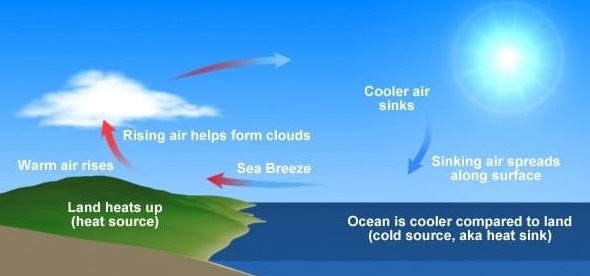
Land breeze
Night mein land water se jyada jaldi heat loose karti hai aur sea ke upar ki air garam hoti hai. Yeh air garam hone ki vajah se upar rise karti hai aur land ke upar vali air uski jagah lene ke liye sea ki taraf move karti hai. Land se sea ki taraf chalne vali air ko land breeze kehte hai aur yeh night time mein chalti hai.

Radiation:
Hum jab bhi sunlight mein bahar jate hai hamein garmi lagne lagti hai. Hamari body aur sun toh direct contact mein nahi aate toh yeh sun rays hamari body ko warm kaise karti hai?
Most part of the space mein air nahi hoti isliye sun rays hamari body tak radiation ki process se aati hai. Radiation se heat transfer karne ke liye kisi medium ki jarurat nahi hoti. Radiations bina kisi medium ke hi heat transfer kar dete hai.
Eg- Ek hot utensil ko flame se door rakhne par vo radiation ke process se hi cool down ho jata hai; Jab hum kisi room heater ke samne baithte hai tab bhi hamein isi process se heat milti hai. Aise aur bhi bahut examples hum apni daily life mein dekhte hai.
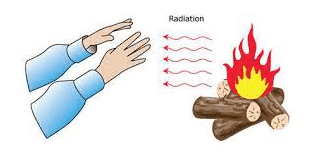
Sari bodies heat radiate karti hai. jab heat kisi object par padti hai toh uska kuchh part reflect ho jata hai, kuchh part absorb ho jata hai aur kuchh part transmit bhi ho jata hai. Lekin body ka temperature only absorbed part of heat ki vajah se raise hota hai.
POINT 2
Conduction: The process by which heat is transferred from hotter end to the colder end of an object is known as conduction.
Conductors Of Heat: The materials which allow heat to pass through them easily are known as conductors of heat.
Insulators: The poor conductors of heat which do not allow the heat to pass through them are known as insulators.
Convection: The mode of transfer of heat from the hotter part of a fluid (liquid or gas) to its colder parts by the movement of the liquid (or gas) itself is known as convection.
Sea breeze: The air which blows from sea to land is known as sea breeze.
Land breeze: The air which blows from land to sea is known as land breeze.
Radiation: The mode of transfer of heat through which heat energy from a hot body to a cold body by means of heat rays without any material medium between them is known as radiation.
Kinds Of Clothes We Wear In Summer And Winter
Summers mein hum light coloured cotton clothes wear karna prefer karte hai kyonki yeh sunlight ke jyada se jyada part ko reflect karte hai aur bahut less amount of heat ko absorb karte hai. Yeh less heat absorb karte hai isliye hamein cotton clothes mein thoda cool feel hota hai.
Winters mein hum dark coloured clothes wear karna prefer karte hai kyonki yeh more amount of heat ko absorb karte hai aur inn clothes mein hum winters mein jyada comfortable aur warm feel karte hai.
Woollen clothes keep us warm in winter
Winters mein hum woollen clothes wear karte hai. Wool heat ka poor conductor hota hai. Woollen clothes mein wool fibres ke beech mein kuchh air trap ho jati hai aur yeh heat ko hamari body se cold surroundings mein flow nahi karne deta isliye woollen clothes mein hum warm feel karte hai.
DIFFERENCE

SUMMARY
1. Our sense of touch is not always a reliable guide to the degree of hotness of an object.
2. Temperature is a measure of the degree of hotness of an object.
3. Thermometer is a device used for measuring temperature.
4. Clinical thermometer is used to measure our body temperature. The range of this thermometer is from 35°C to 42°C. For other purposes, we use the laboratory thermometers. The range of these thermometers is usually from –10°C to 110°C.
5. The normal temperature of the human body is 37°C.
6. The heat flows from a body at a higher temperature to a body at a lower temperature. There are three ways in which heat can flow from one object to another. These are conduction, convection and radiation.
7. In solids, generally, the heat is transferred by conduction. In liquids and gases the heat is transferred by convection. No medium is required for transfer of heat by radiation.
8. The materials which allow heat to pass through them easily are conductors of heat.
9. The materials which do not allow heat to pass through them easily are called insulators.
10. Dark-coloured objects absorb more heat than the light-coloured objects. That is the reason we feel more comfortable in light-coloured clothes in the summer.
11. Woollen clothes keep us warm during winter. It is so because wool is a poor conductor of heat and it has air trapped in between the fibres.